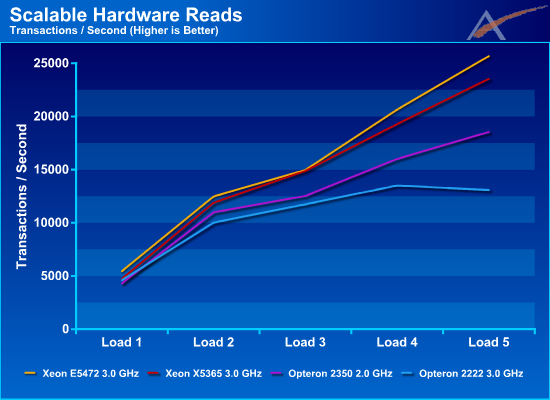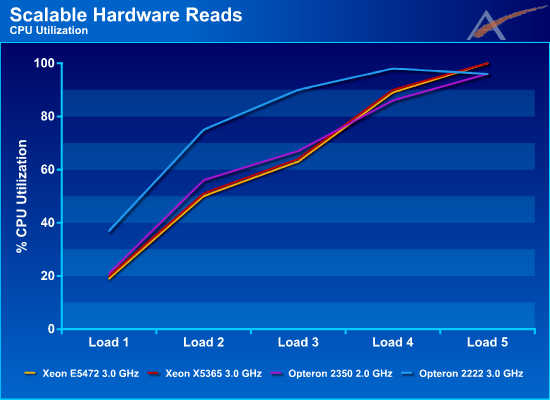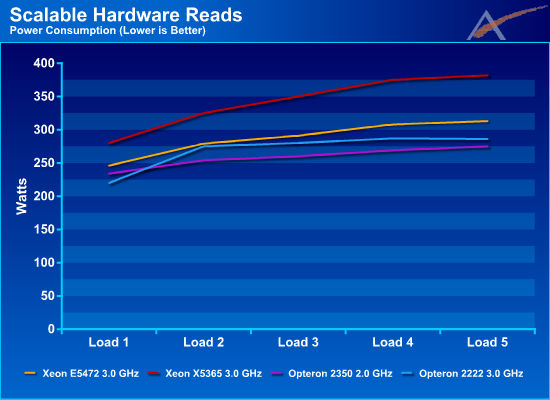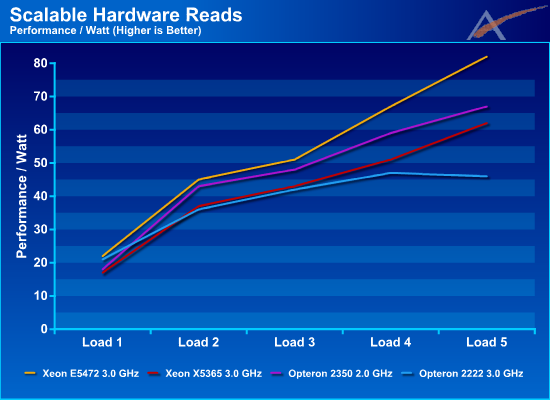Intel "Harpertown" Xeon vs. AMD "Barcelona" Opteron
by Jason Clark & Ross Whitehead on September 18, 2007 5:00 PM EST- Posted in
- IT Computing
Scalable Reads

This is yet another benchmark where Intel dominates and the Xeon E5472 performs better than the same clocked Xeon X5365. Harpertown is as much as 39% faster than Barcelona.

Here we see similar results to previous CPU utilization graphs.

Again, Intel is getting closer to AMD power use, but they're not quite there (and likely won't be while using FB-DIMMs).

Harpertown is once more the clear leader here. Harpertown is able to lead Barcelona by as much as 22%. In this test, however, Barcelona is able to surpass Clovertown efficiency.

This is yet another benchmark where Intel dominates and the Xeon E5472 performs better than the same clocked Xeon X5365. Harpertown is as much as 39% faster than Barcelona.

Here we see similar results to previous CPU utilization graphs.

Again, Intel is getting closer to AMD power use, but they're not quite there (and likely won't be while using FB-DIMMs).

Harpertown is once more the clear leader here. Harpertown is able to lead Barcelona by as much as 22%. In this test, however, Barcelona is able to surpass Clovertown efficiency.










77 Comments
View All Comments
Final Hamlet - Wednesday, September 19, 2007 - link
I don't wanna argue with you over AMD vs. Intel, because you know: Doing so on the Internet is like running in the Special Olympics - even if you win, you are still retarded...Nevertheless, you can't even calculate.
If 2.0 GHz is the basis and you lift it to 2.5 GHz, it is NOT a 20% improvement, but RATHER 25%. Learn calculating percentages, it helps man, it helps...
DigitalFreak - Tuesday, September 18, 2007 - link
Dude, you just don't have a clue....Accord99 - Tuesday, September 18, 2007 - link
Barcelona only kills on $/performance because it's being compared to the higher-end Intel SKUs . There are much cheaper 2.33GHz Clovertowns and comparable Harpertowns. Meanwhile Harpertown pretty much guarantees Intel performance superiority for the forseeable future.Justin Case - Tuesday, September 18, 2007 - link
Beyond a certain price difference, it's cheaper to buy two systems than to buy a faster system. Most (granted, not all) software that can run efficiently on multi-core CPUs can also run efficiently on multiple nodes. A single, more expensive system can still be preferable if you have space constraints, of course, but I suspect Intel will lower its prices a bit as a response to Barcelona.Personally I would like to see a comparison between two systems with a similar price.
Accord99 - Tuesday, September 18, 2007 - link
Most (granted, not all) software that can run efficiently on multi-core CPUs can also run efficiently on multiple nodes.I wouldn't say most, more like a few. Plus, a lot of expensive software are licensed by the socket, so any savings on the CPU is minor compared to the overall costs of software.
Two systems also take up more space and consume more power, and the trend of virtualization also leads to fewer, bigger servers.
Justin Case - Tuesday, September 18, 2007 - link
Just out of curiosity, what software are you thinking about that scales well to multiple cores but cannot run on multiple nodes?Rendering can be done in render farms, most servers can run in multi-node load-balancing configrations, etc.. The only field that comes to mind where multiple nodes really aren't doable is scientific / HPC, which needs very fast access to a shared memory pool. But the days of glory of the monolithic supercomputer are kind of past.
chucky2 - Tuesday, September 18, 2007 - link
At work (extremely large telecomm company) we don't run each box more than 50% load for failover reasons. So when I'm looking at these numbers, to me it seems like AMD is doing pretty good with 2.0GHz CPU's vs. 3.0GHz Intel CPU's.I'd really like to see how the scaling goes with Barcelona from say 2.0, 2.5, and 3.0GHz.
I think at 2.5-2.7GHz is when we're really going to see Barcelona start to come into its own...
Chuck
Justin Case - Tuesday, September 18, 2007 - link
I think this shows the same trend from the previous generation, in terms of performance per watt: AMD rules for servers (low / medium CPU loads), Intel rules for workstations and render nodes (high CPU loads).And both are complete overkill for desktop systems, but I'm sure Microsoft will find a way to make Windows crawl on them. :)
HPC / FEA / etc. is also high CPU load but it also needs low memory latency and high bandwidth (where AMD has an advantage), so these benchmarks don't really tell us much. My guess is Intel will have a small advantage (despite the slower memory access), at least until Barcelona hits 2.5 GHz or so.
firewolfsm - Tuesday, September 18, 2007 - link
This review seems biased. If you want to run only the 2GHz part at least calculate the performance per clock because it looks like Barcelona has Intel beat in a lot of the benchmarks. Meaning 2.5GHz would be much more competitive. and you also should have run the 3.2 GHz K8.Jason Clark - Tuesday, September 18, 2007 - link
As for 3.2GHz, our reasoning was it was a high wattage part, and it didn't make sense to include it. At the wattage it runs at, perf/watt was not pretty.